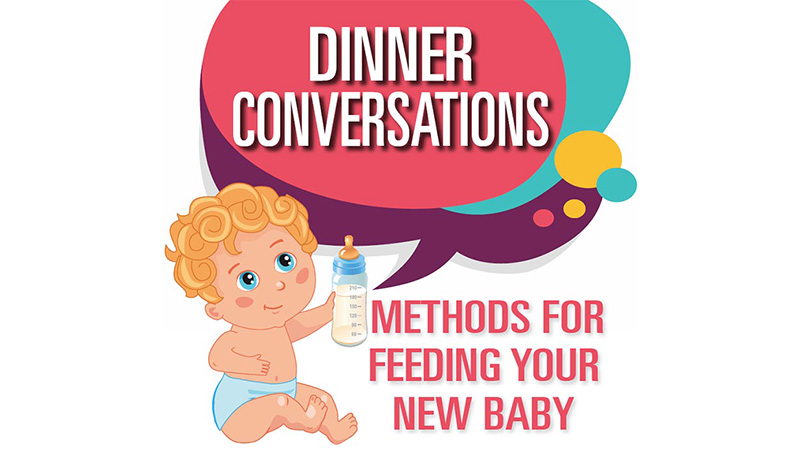Remember when social media didn’t exist, and new mothers weren’t constantly bombarded with hundreds of different blogs, articles and videos about breast-feeding versus bottle-feeding a baby? It was a simpler time then, when parents made decisions apart from mass media. Instead they based their baby’s nutrition on his or her individual needs as well as private discussions with their physician.
The good news is, that time has returned. More and more moms are turning away from social media pressure pertaining to feeding methods, and they’re willing to share why they made these choices. Word-of-mouth can only take you so far when it comes to parenting, especially when you’re talking about feeding your baby. At some point, it is best to simply listen to your gut – and your baby’s gut as well.
HealthLinks Charleston had the pleasure of speaking with two new mothers, each with stories to share about breast-feeding and bottle-feeding, as well as local pediatrician Dr. Elizabeth Milliron of Coastal Pediatric Associates, who has counseled numerous families on the topic.
“I didn’t put too much thought into whether I would breastfeed,” admitted Angi Klick, mother to three daughters between the ages of 4 months and 5 years who were all breast-fed. “I never thought of doing anything different.”
Klick said she felt no pressure from the media, other moms or even her own mother, a registered nurse. Instead, she decided to breast-feed on her own, citing research about boosting a baby’s immunity and helping the mother recover quickly, too.
Meredith Mosny, mom of a 22-month-old daughter, Caleigh, admitted that she was disappointed and a little hard on herself when she wasn’t able to breast-feed. However, she found satisfaction in formula – trying both nondairy and dairy varieties at different points in Caleigh’s development – and said she’s confident that her daughter enjoyed mealtime just as thoroughly.
“I intended to breast-feed and I had a pump, but I couldn’t produce and she wouldn’t latch,” Mosny said. “So I started using Enfamil, and we both loved it.”
“While breast-feeding is the most optimal nutrition for the majority of babies, it is not always feasible for the baby or the mother,” noted Dr. Milliron.
New mothers who are learning to feed a newborn often seek support from mom groups, lactation consultants or family. Breast-feeding and bottle-feeding understandably lead to different kinds of support, and both Klick and Mosny spoke favorably about their experiences. According to Klick, one of the best things she did with her first child, Ada, was join a lactation support group, where she said she met friends with babies.
Meanwhile, Mosny raved about the perk of staying on the go with her bottle-fed baby. She enjoyed taking her daughter on various outings and engaging her in social situations with other mothers and children.
Interestingly, the idea of convenience prevailed for both families, albeit for different reasons. For Klick, breast-feeding didn’t require dishes and was more cost-effective. For Mosny, the onthe- go packet of formula meant that meals could materialize almost anywhere.
“You can mix water and formula together wherever,” she noted. As for ladies wondering if Klick fed her daughters wherever she wanted, the answer is yes.
“I try to stay active and participate regularly in triathlons,” she commented, “and one time, I had to seek a private spot off to the side of the starting line and feed Ella Cate.” She laughed. “I hoped no one noticed me, but a few people actually came to me later and said they admired it.”
Even within one family, babies can react to formula and breast milk differently. According to Klick, getting her second daughter, Gracie, to breast-feed did not come as naturally.
“I even had the lactation consultant come to my house for Gracie,” she commented. “But with Ella Cate, it’s been seamless.”
“Breast-feeding mothers may have trouble with latch, supply or baby’s feeding coordination,” said Dr. Milliron. “However, many of these issues can be overcome with the right support.”
Klick said she believes that breast milk is the best food for Ella Cate, who suffers from acid reflux. Mosny’s daughter Caleigh, on the other hand, showed signs of having a milk allergy and fared well with nondairy formula until she got a few months under her belt, then switched to a dairy-based version without any issues.
“There are millions of different kinds of supplements,” Mosny emphasized.
“With formula-feeding, moms have to find the type of formula that best works for their infant and navigate the many types – cow’s milk, soy, hydrolyzed and low lactose, to name a few,” Dr. Milliron pointed out.
Having met both Klick and Mosny’s daughters in person, I can vouch for these children being friendly, engaged in the conversation and active. In fact, Klick’s oldest daughter drew me a heartfelt work of art, while Mosny’s daughter shared her favorite Disney character with me, a cat known as Sheriff Callie. After meeting these two families, I had no doubt that each mother can choose a feeding method that best suits her own baby – and that the rest will fall into place.
“Caleigh is just as smart as any boy or girl her age, and she’s never sick,” Mosny mused. “And when it comes to food nowadays, she’ll eat anything, even a salad!”
“Breast-feeding has worked for my daughters, so I’ve stuck with it,” added Klick. “It’s about giving them the healthiest start possible.”
“Trust your gut when it comes to what is right for your baby, and, if you have questions, talk with your pediatrician,” Dr. Milliron added. “It is important for mothers to realize the most optimal thing is for a baby to be fed and loved and for the family as a whole to be happy and healthy, no matter what the feeding method.”







